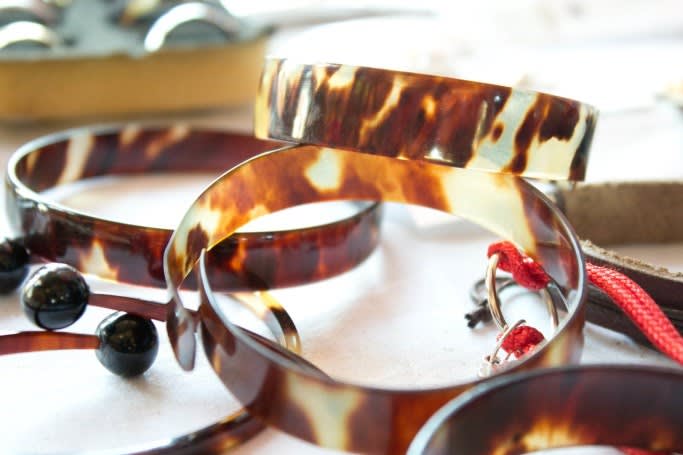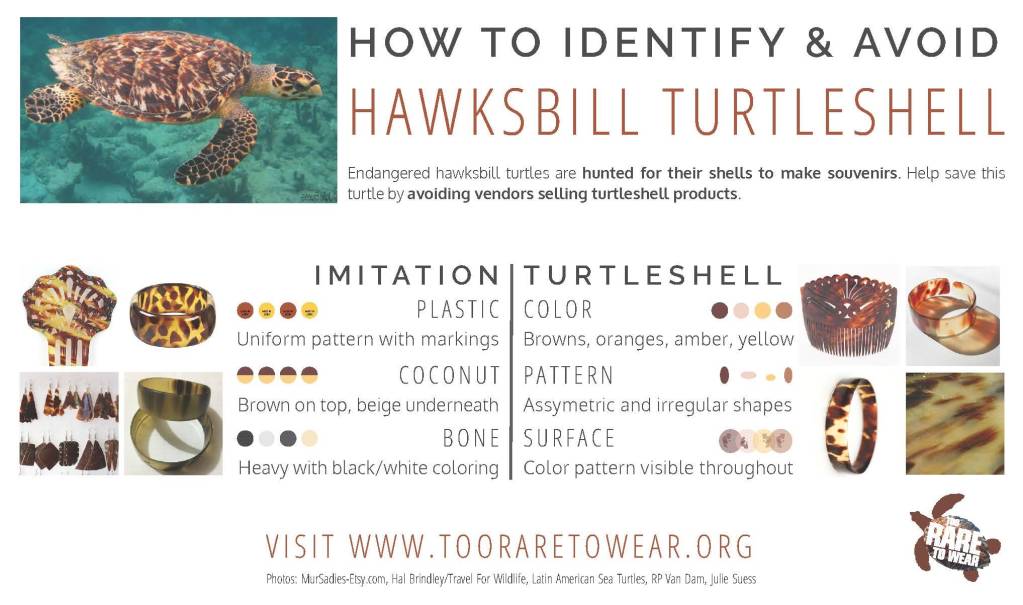Read time – 4 minutes
When we travel, we often purchase souvenirs as a tangible memory of the trip. However, many unknowingly come home with souvenirs that are actually made from animal parts which may be illegal.
Despite having an international agreement signed in more than 181 countries, the trade of endangered species is a perpetual problem. In many destinations, souvenirs made from endangered species are still openly sold, allowing tourists to purchase them without knowing that they are unwittingly destroying the environment and its ecosystem.
Help Save Endangered Species
Hawksbill Sea Turtles
One of these endangered species is the Hawksbill sea turtle. They are currently listed as “critically endangered” with an estimate of only 15,000 adult females left in the world. Why is this so?
 Hawksbill sea turtle
Hawksbill sea turtle
Hawksbill sea turtles are one of the most beautiful turtle species in the ocean, making them vulnerable to human activities as they are hunted primarily for their stunning shells. Their shells are used to make trinkets and sold to travellers in markets across Latin America and the Caribbean as well as other tropical regions.
In response, this led to an emergence of sea turtle conservation organisations and projects aimed to preserve these beautiful sea creatures, before it is too late.
Too Rare To Wear
Too Rare To Wear is a coalition of various conservation and travel organisations with the goal to end the demand of turtle shell products in Latin America by educating travellers on the situation of the hawksbill and advising them on how to identify and avoid hawksbill products.
Hawksbill sea turtles are worth protecting in their own right as they hold a crucial role in the ocean ecosystem, particularly to the health of coral reefs. Primarily, they feed on sponges which are multi-celled animals with the ability to overgrow and dominate the corals in the ecosystem.
It is estimated that one hawksbill turtle can eat over 1,000 pounds of sponges each year. By consuming these sponges, they allow other species to occupy space on the reef, increasing biodiversity.
 Turtle shell bracelets
Turtle shell bracelets
In their latest report, they conducted an investigation to evaluate turtle shell trade in tourist hotspots within selected countries in Latin America. Dreadfully, the sale of hawksbill turtle shell products was observed in eight of the nine countries investigated.
In particular, four of the countries are destinations that Exodus groups go to specifically South America, Costa Rica, Panama and Colombia. Hence, we encourage responsible travel to ensure our clients are aware of this issue and avoid purchasing any hawksbill turtle shell products.
If you know that you are travelling to Latin America or simply just want to play a part in ending the demand for hawksbill turtle shell, here are 3 simple tips for you!
Ways to support sea turtle conservation
1. Learn how to identify hawksbill turtle shell products and avoid it.

This guide from Too Rare To Wear lays out the differences between hunted turtle shell and safe imitation. If you’re still unsure, ask your leader for advice. If in doubt, entirely avoid buying anything that looks like .
2. If you do see hawksbill items being sold, report it.
You can help address this trade by filling out a form through Too Rare to Wearto help reduce demand for these products and help hawksbills thrive again.
3. Choose to support local artisans instead
There are plenty of local craftspeople and traditions that produce alternative souvenirs, such as crafts made from coconut shell, which support local people without supporting the turtle shell trade.
For more information on the campaign, please visit Too Rare to Wear.
You can also pledge to avoid turtle shell here
 Sea turtle
Sea turtle
Browse our trips below.








